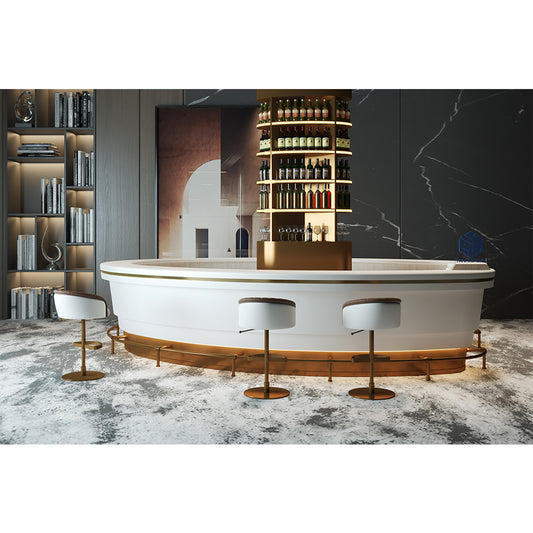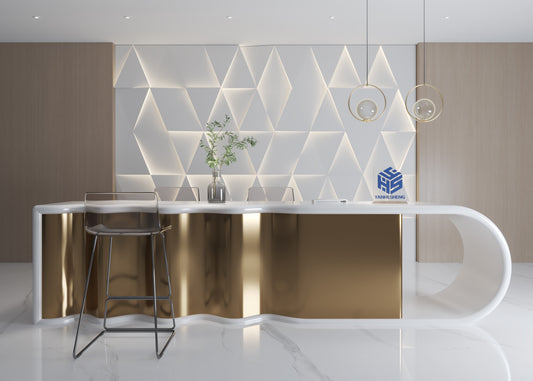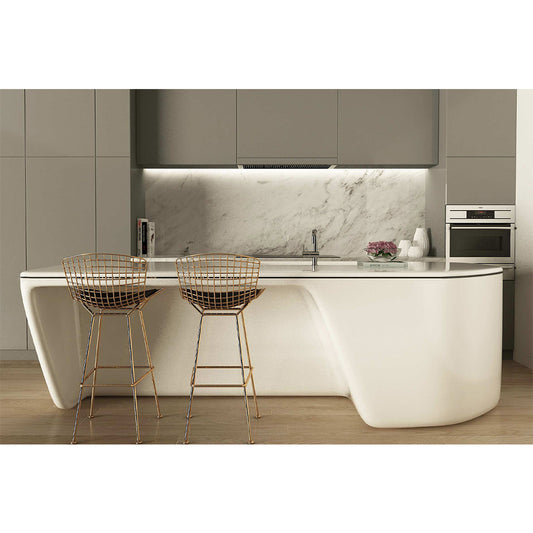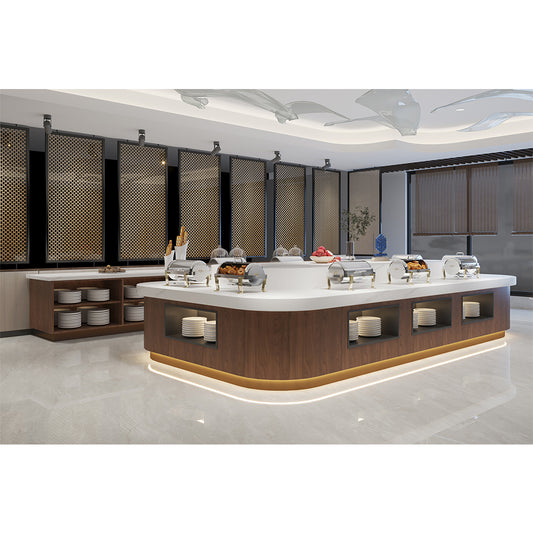Counter and Bar Tables play a key role in both residential and commercial spaces, offering a blend of function and style. Whether used for casual dining, socializing, or as a centerpiece in a restaurant or bar, these tables come in various designs and materials to suit different tastes and environments. This guide explores the types, materials, customization options, and best practices for sourcing counter and bar tables, especially from manufacturers in China like YHS.
1. Understanding Counter & Bar Tables: Key Differences
Counter and bar tables differ primarily in height, which influences their functionality and seating arrangements.
Counter Tables
- Height: 34 to 36 inches (86 to 91 cm), designed to pair with stools or chairs that are 24 to 26 inches high.
- Use: Ideal for kitchen islands, casual dining spaces, and home bars. Counter tables offer a comfortable height for everyday use in both residential and commercial settings.
Bar Tables
- Height: 40 to 42 inches (101 to 107 cm), typically paired with stools 28 to 30 inches high.
- Use: Often found in commercial settings such as restaurants, pubs, and bars. Bar tables promote a more social, upright seating arrangement, which makes them great for mingling and casual conversation.
2. Material Options for Counter & Bar Tables
When selecting a counter or bar table, the material choice greatly affects the durability, appearance, and maintenance of the table. Here are common materials to consider:
a. Solid Surface
Solid surface tables are popular for both counter and bar heights due to their versatility and low maintenance:
- Durable and Hygienic: Solid surfaces are non-porous, making them resistant to stains and bacteria, which is crucial for restaurant and bar environments.
- Seamless Design: Available in large, seamless designs, these tables are ideal for both commercial and home use where aesthetics and easy cleaning are important.
- Customizable Colors and Patterns: Solid surface materials can be color-matched to fit any design, including marble or stone-look finishes.
b. Quartz Stone
Quartz stone is a premium option that offers a sophisticated look and long-lasting durability:
- Scratch and Heat Resistant: Quartz is ideal for high-traffic areas like restaurants and bars, where heavy use is expected.
- Luxurious Appearance: Quartz tables often have a polished finish, creating a sleek, elegant look.
- Variety of Colors: Available in neutral tones, quartz can be customized with patterns that resemble natural stone.
c. Wood
Wooden counter and bar tables are timeless and versatile:
- Natural Appeal: Wood brings warmth and character to any space, with popular choices like oak, walnut, or pine.
- Staining and Finishing Options: The wood can be stained in various shades or painted, allowing for a high degree of customization.
d. Metal
Metal is often used in the base of bar and counter tables for added strength and an industrial aesthetic:
- Durability: Stainless steel or cast iron bases are sturdy and long-lasting.
- Finishing Options: Metal bases can be brushed, polished, or painted, offering a sleek or rustic look depending on the finish.
3. Customization Options for Counter & Bar Tables
Customizing your counter or bar table is a great way to ensure it fits perfectly in your space, whether you're outfitting a restaurant or a kitchen.
a. Size and Shape Customization
You can customize the size and shape to meet your specific needs:
- Counter Tables: Rectangular, round, or square shapes are common, with dimensions typically around 36 inches in height. Custom heights can also be made for specific needs.
- Bar Tables: Often taller and narrower, bar tables can be circular or rectangular. Heights typically range from 40 to 42 inches.
b. Edge Profiles
Edge profiles add to the table’s design and functionality:
- Straight Edge: Clean and modern, often used for minimalist designs.
- Beveled Edge: A more classic option that adds a touch of elegance with a tapered edge.
- Bullnose Edge: Rounded edges create a softer, more casual appearance, great for homes or family-friendly environments.
c. Color and Finish Options
Many manufacturers offer custom color matching for solid surface and quartz materials, allowing you to create a cohesive look:
- Solid Surface: Can be customized in a wide range of colors and patterns, from bright, solid colors to marble-like finishes.
- Quartz: Typically more neutral, quartz can be customized with intricate patterns that mimic natural stone.
d. Logo and Branding
For commercial spaces, adding a custom logo to your counter or bar table can enhance brand visibility. Manufacturers like YHS offer CNC engraving services, allowing logos or designs to be carved into the table surface.
4. Sourcing Counter & Bar Tables from Chinese Manufacturers
When sourcing custom furniture from China, manufacturers like YHS provide extensive options for customization at competitive prices. Here are some key factors to consider:
a. Minimum Order Quantity (MOQ)
When ordering custom tables from manufacturers, you’ll need to meet the minimum order quantity:
- Solid Surface Tables: MOQ is typically around 30 pieces.
- Quartz Countertops: Often requires an MOQ of 50 sets for custom orders.
b. Lead Time
Custom orders generally take time to produce. For example, YHS offers a lead time of 20-25 working days for custom solid surface and quartz tables.
c. Packaging and Shipping
Proper packaging ensures your tables arrive in perfect condition. YHS uses protective packaging such as wooden crates or pallets with foam padding to prevent damage during transit. Shipping times vary depending on location but typically take a few weeks after production.
5. Best Practices for Choosing the Right Table
When choosing a counter or bar table for your space, consider the following factors:
a. Functionality
Consider how the table will be used. For high-traffic commercial environments, you’ll want durable materials like quartz or solid surface that can withstand heavy use. For residential spaces, wood or a combination of wood and metal might offer the warmth and style you're seeking.
b. Space Considerations
Measure the space where the table will be placed. Ensure there is enough room for seating and movement around the table. For instance, round tables work well in smaller spaces, while rectangular tables can accommodate more people in larger rooms.
c. Aesthetic
Choose a material and design that complements your existing décor. For a sleek, modern look, solid surface or quartz tables in neutral tones are ideal. For a more rustic or traditional feel, wood is the perfect choice.
6. Conclusion
Counter and bar tables are essential furniture pieces for both residential and commercial spaces. Whether you’re designing a home kitchen or outfitting a restaurant, choosing the right material and customization options can significantly enhance the functionality and aesthetic of your space. Sourcing from reliable manufacturers like YHS in China offers the flexibility of custom designs, high-quality materials, and competitive pricing. By considering factors like material durability, customization options, and proper sourcing practices, you can find the perfect table to meet your needs.





